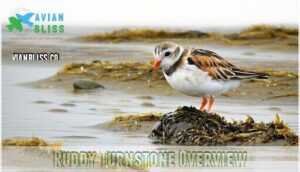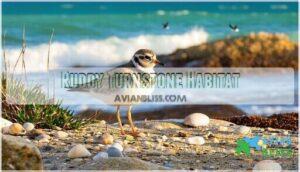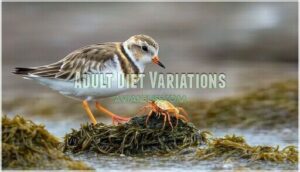This site is supported by our readers. We may earn a commission, at no cost to you, if you purchase through links.

These stocky shorebirds sport a distinctive calico pattern with orange-red legs and a wedge-shaped bill perfect for prying.
During breeding season, they nest in the Arctic tundra before making epic migrations to winter on beaches worldwide.
Their acrobatic foraging style sets them apart from other sandpipers – they’re nature’s little archaeologists, methodically overturning rocks, shells, and seaweed.
These hardy birds can live over 15 years, making the same incredible journeys between polar breeding grounds and tropical beaches, showcasing their unique feeding strategy and fascinating adaptations that make them masters of coastal survival.
Table Of Contents
- Key Takeaways
- Ruddy Turnstone Overview
- Ruddy Turnstone Habitat
- Ruddy Turnstone Diet
- Ruddy Turnstone Breeding
- Ruddy Turnstone Conservation
- Frequently Asked Questions (FAQs)
- What is a ruddy turnstone?
- Where do ruddy turnstone birds live?
- Are ruddy turnstones active during the day?
- What does a ruddy turnstone sound like?
- What is the size of an adult ruddy turnstone?
- Do ruddy turnstones have orange legs?
- Where are Ruddy Turnstones found?
- Are Ruddy Turnstones endangered?
- What is a ruddy turnstone in Florida?
- What are some interesting facts about the ruddy turnstone?
- Conclusion
Key Takeaways
- You’ll easily identify ruddy turnstones by their unique stone-flipping behavior and bright orange legs as they methodically overturn rocks and debris to hunt for hidden invertebrates underneath
- You can spot these stocky shorebirds across diverse habitats from Arctic tundra breeding grounds to tropical coastlines worldwide, making epic 18,000+ mile migrations twice yearly
- You’ll witness their specialized foraging techniques that set them apart from other sandpipers – they’re nature’s archaeologists who can flip stones twice their body weight using their wedge-shaped bills
- You’ll find these hardy birds maintain stable populations despite facing habitat loss and climate change, with conservation efforts protecting key stopover sites along their incredible migration routes
Ruddy Turnstone Overview
You’ll recognize the Ruddy Turnstone by its distinctive stone-flipping behavior along rocky coastlines and sandy beaches.
Watch these acrobatic shorebirds masterfully flip stones twice their weight to uncover hidden treasures beneath.
This stocky shorebird measures 8.7 to 9.4 inches long with striking orange legs and a harlequin-patterned breeding plumage of black, white, and russet colors.
Physical Characteristics
From beak to tail, you’ll notice the ruddy turnstone’s stocky build measures 8.7-9.4 inches long.
This shorebird’s plumage variation shifts dramatically between seasons, while its distinctive bill morphology and bright orange leg coloration remain constant.
One key aspect involves understanding plumage color terminology for accurate identification.
Here’s what makes this ruddy turnstone special:
- Size dimorphism – females slightly larger than males
- Foot adaptations – spiny feet grip slippery rocks
- Physical description – harlequin breeding plumage with russet color
Identification Features
You’ll spot ruddy turnstones by their distinctive seasonal changes.
During breeding plumage, they show striking harlequin patterns with reddish-brown upperparts and bold black-and-white markings.
Winter plumage appears much duller with grayish-brown tones.
Their bright orange legs stand out year-round, while their short, wedge-shaped bill helps with shorebird identification among mixed flocks, characterized by their reddish-brown upperparts and bold black-and-white markings.
Habitat and Distribution
You’ll find these remarkable shorebirds across a stunning global distribution that spans multiple continents.
Their Arctic breeding grounds stretch from Alaska to Siberia, while their coastal habitats during winter reach nearly every temperate shoreline worldwide.
Key turnstone habitat locations:
- Arctic tundra breeding grounds in Alaska, Canada, Greenland, and Scandinavia
- Wintering grounds along Atlantic and Pacific coasts of North and Central America
- European, African, and Asian coastlines during migration routes
- Rocky shores, sandy beaches, mudflats, and estuaries year-round
Ruddy Turnstone Habitat
You’ll find ruddy turnstones across diverse habitats from Arctic tundra to tropical coastlines throughout their remarkable annual journey.
These adaptable shorebirds breed in the harsh conditions of northern regions but spend most of their year along temperate and warm coastal areas worldwide, showcasing their ability to thrive in various environments, with remarkable adaptability being a key factor.
Breeding Grounds
You’ll discover ruddy turnstones’ Arctic nesting grounds across Alaska, northern Canada, Greenland, and Siberian tundra.
These hardy birds choose open, exposed sites near rocky coastlines for breeding. Arctic Tundra provides perfect conditions for egg incubation during brief summer months.
For supplemental shelter, consider a turnstone nesting box. Parental roles involve females building shallow ground scrapes while both sexes share nesting duties through the demanding chick fledging process.
Winter Migration
After breeding season ends, you’ll witness these remarkable shorebirds set out on epic journeys spanning continents.
Their longdistance migration showcases incredible endurance as flocks navigate diverse migration routes.
Winter migration patterns reveal fascinating dynamics:
- Migration Routes stretch from Arctic breeding grounds to temperate and tropical wintering grounds worldwide
- Coastal Stopovers provide essential refueling stations where food availability determines survival success
- Flock Dynamics shift dramatically as thousands gather along shorelines during migratory patterns
- Climate Impacts increasingly affect traditional winter diet sources and timing
Coastal Regions
Along rocky shores and sandy beaches, you’ll encounter ruddy turnstones adapting to diverse coastal ecosystems.
These coastal birds face mounting challenges from coastal erosion and habitat loss.
Climate change alters their traditional feeding grounds while human impact disrupts turnstone migration routes.
Despite conservation efforts, turnstone behavior must constantly adjust to shrinking coastal habitats that support their specialized turnstone diet.
These birds also play a role in marine food webs.
Ruddy Turnstone Diet
You’ll discover that the Ruddy Turnstone’s diet changes dramatically with the seasons and their location.
These adaptable shorebirds switch from hunting insects during Arctic breeding season to flipping stones for crustaceans and mollusks along winter coastlines, which showcases their ability to adapt to new locations.
Adult Diet Variations
Adult turnstones showcase remarkable Diet Adaptability through Seasonal Food shifts and Regional Differences. These skilled foragers switch from Arctic insects to coastal invertebrates, crustaceans, and mollusks based on location and season.
Their Opportunistic Feeding strategy guarantees survival across diverse habitats. Black vultures, unlike turnstones, often exhibit preferences for carrion.
Turnstone diet variations include:
- Spring migration: 65% amphipods dominate Prey Preference in temperate zones
- Arctic breeding: 72% fly larvae fuel nesting energy needs
- Winter coasts: Marine crustaceans and mollusks provide essential fats
- Urban beaches: 18% human scraps supplement natural foraging opportunities
Chick Diet Composition
Chick feeding behavior shifts dramatically from adults.
Young turnstones show Insect Dominance in their diet, consuming spiders, beetles, and Larval Consumption of flies during Arctic breeding.
They’ll grab Berry Supplement nutrients and occasionally practice Egg Consumption from nearby nests.
Carrion Intake provides extra protein when available.
This specialized bird diet supports rapid growth, with feeding behavior adapted for catching small invertebrates.
Chicks require protein-rich diet for successful development.
Foraging Techniques
You’ll discover that ruddy turnstones excel at Stone Flipping and Collaborative Foraging to find hidden prey.
Their specialized probing techniques and Diet Adaptations make them masters of Prey Detection during Tidal Feeding cycles, efficiently uncovering invertebrates beneath rocks and debris.
Many tools can assist with similar foraging behaviors.
- Stone Flipping: Use their wedge-shaped bills to overturn rocks, shells, and seaweed up to their own body weight
- Group Foraging: Work together in flocks to tackle larger objects and share foraging sites efficiently
- Tidal Feeding: Time their feeding with low tides for maximum access to exposed invertebrates and marine prey
Ruddy Turnstone Breeding
You’ll find ruddy turnstones establish their breeding territories on Arctic tundra from May through August.
These hardy shorebirds form monogamous pairs within days of arriving at their northern breeding grounds and engage in elaborate courtship displays before nesting.
Nest Placement Strategies
Ruddy Turnstones choose nest sites with strategic precision. These Arctic breeders select ground locations that balance camouflage importance with predator avoidance needs.
You’ll find their nests near vegetation proximity for cover, yet positioned to allow quick escape routes. Their ground nesting behavior includes selecting spots among rocks or low plants where the mottled eggs blend seamlessly with surroundings.
This careful nest site selection demonstrates sophisticated breeding habits that maximize survival chances during the vulnerable breeding season, showcasing their ability to adapt and ensure the continuation of their species through predator avoidance and effective use of camouflage importance.
Nest Description Details
When you locate a Ruddy Turnstone nest, you’ll find a surprisingly simple yet effective design.
These ground-nesting birds create shallow depressions that blend seamlessly into their Arctic surroundings.
Here’s what makes their nests special:
- Nest Building Materials: Females line the scrape with nearby vegetation like leaves, moss, and small twigs
- Nest Camouflage: The shallow depression disappears among rocks and tundra plants, protecting eggs from predators
- Nest Dimensions: Each scrape measures roughly 4-5 inches across and just 1-2 inches deep
The female’s careful Nest Site Selection guarantees the best Egg Placement within these modest quarters, creating a safe haven for future hatchlings; this choice is influenced by environmental factors.
Mating Behavior Patterns
You’ll witness nature’s most enchanting bird courtship rituals when males perform aerial acrobatics with rapid wingbeats.
Males chase females while presenting food gifts and emit repeated territorial calls.
These elaborate Courtship Displays strengthen the Pair Bond through synchronized dance movements and mutual preening before Mate Selection occurs.
| Behavior Type | Description |
|---|---|
| Aerial Displays | Rapid wingbeats with direction changes |
| Food Presentation | Males offer nuptial gifts to females |
| Vocal Signaling | Repeated calls for Territorial Defense |
| Ground Chasing | Males pursue females on foot |
| Mutual Preening | Bond-strengthening grooming rituals |
Breeding Season Timeline
You’ll observe pairs forming within days of arrival timing at Arctic breeding grounds in May.
Courtship displays strengthen bonds through the first week of June.
Nest building begins immediately after pairing, with females creating shallow scrapes.
The incubation period spans 22-24 days, with both parents sharing duties.
Chick fledging occurs at 19-21 days old, while parental roles shift as males assume primary care responsibilities after females depart early.
Ruddy Turnstone Conservation
You’ll find that Ruddy Turnstones face several conservation challenges despite their wide global distribution.
These remarkable shorebirds depend on specific coastal stopover sites during migration, making them vulnerable to habitat loss and climate change impacts.
Migration Patterns Overview
These migratory birds travel incredible Migration Distances—some covering over 18,000 miles annually between Arctic breeding grounds and tropical wintering areas.
These aerial athletes journey over 18,000 miles annually from Arctic tundra to tropical shores.
You’ll witness remarkable endurance as flocks navigate complex migratory routes with strategic stops at essential stopover areas.
Consider purchasing migration themed products to support conservation efforts.
- Stopover Sites: Delaware Bay serves as a critical refueling station where thousands gather to feast on horseshoe crab eggs
- Flock Dynamics: Winter groups can swell from dozens to several thousand birds, often mixing with other shorebird species
- Route Variations: Climate Impacts are shifting traditional bird migration patterns, forcing adaptations to changing coastal conditions
Conservation Status Update
You’ll find the Ruddy Turnstone’s IUCN conservation status as "Least Concern" despite population trends showing moderate decline.
Global numbers range from 460,000 to 800,000 individuals. However, conservation efforts remain active as habitat loss and climate change pose growing challenges.
The species’ widespread distribution helps maintain its stable outlook, though regional populations face varying degrees of pressure across different flyways.
Threats and Protection Measures
Despite facing multiple threats, you’ll find ruddy turnstones benefit from growing conservation efforts.
Habitat loss affects 35% of breeding areas, while climate change disrupts migration timing by 25%.
Pollution impact includes microplastic ingestion in 18% of birds.
However, hunting regulations protect key sites, and conservation efforts have established 30 Important Bird Areas, reducing nest failures by 15% through community monitoring programs.
Frequently Asked Questions (FAQs)
What is a ruddy turnstone?
Measuring just 9 inches long, you’ll spot a ruddy turnstone by its distinctive stone-flipping behavior along coastlines.
This stocky shorebird breeds in Arctic tundra but winters on beaches worldwide, using its wedge-shaped bill to overturn rocks and debris while hunting invertebrates.
Where do ruddy turnstone birds live?
You’ll find ruddy turnstones breeding in Arctic tundra across Alaska, Canada, Greenland, Scandinavia, and northern Siberia.
During winter, they migrate to coastlines worldwide, including Massachusetts, California, Central America, Europe, Africa, Australia, and Pacific islands.
Are ruddy turnstones active during the day?
Yes, ruddy turnstones are diurnal birds—they’re most active during daylight hours.
You’ll spot these feathered acrobats flipping stones and hunting for invertebrates when the sun’s up, not skulking around at night.
What does a ruddy turnstone sound like?
You’ll hear ruddy turnstones making sharp "tuk-tuk-tuk" or "kek-kek-kek" calls while foraging. During breeding season, they produce melodic trilling sounds and rattling calls for courtship and territorial displays.
What is the size of an adult ruddy turnstone?
Picture a compact shorebird with bright orange legs darting across rocky coastlines.
You’ll spot an adult ruddy turnstone measuring 7-4 inches long, weighing 3-3 ounces, with a 20-22 inch wingspan.
This size is perfectly sized for stone-flipping adventures.
Do ruddy turnstones have orange legs?
Yes, ruddy turnstones have bright orange legs. These vibrant yellow-orange legs are one of their most distinctive features, creating a striking contrast against their plumage throughout the year.
Where are Ruddy Turnstones found?
Roaming ruddy turnstones range remarkably wide.
You’ll find them breeding in Arctic tundra across Alaska, Canada, Greenland, and northern Siberia.
During winter, they migrate to coastlines worldwide, including both American coasts, Europe, Africa, Australia, and Pacific islands, which is a remarkably wide range.
Are Ruddy Turnstones endangered?
You won’t find Ruddy Turnstones on endangered lists—they’re listed as near threatened by the International Union for Conservation.
Habitat loss concerns scientists, but these adaptable shorebirds maintain stable populations across their global range.
What is a ruddy turnstone in Florida?
You’ll spot these incredible acrobatic shorebirds performing their signature stone-flipping act along Florida’s beaches and mudflats.
Ruddy turnstones migrate through and winter in Florida, showcasing their distinctive orange legs and harlequin-patterned plumage while hunting invertebrates beneath rocks.
What are some interesting facts about the ruddy turnstone?
You’ll find ruddy turnstones fascinating because they’re acrobatic foragers who flip stones and shells to uncover hidden prey beneath.
These remarkable shorebirds migrate incredible distances from Arctic breeding grounds to tropical wintering areas worldwide, which makes them remarkable shorebirds.
Conclusion
Like a living compass, the ruddy turnstone navigates 20,000-mile journeys twice yearly with pinpoint accuracy.
You’ve discovered a remarkable shorebird that perfectly balances Arctic breeding grounds with tropical wintering beaches.
The ruddy turnstone’s stone-flipping technique and calico plumage make it instantly recognizable along coastlines worldwide.
Whether you’re watching them methodically overturn rocks or witnessing their incredible migrations, these hardy birds demonstrate nature’s most impressive survival adaptations.
Next time you visit rocky shores, you’ll appreciate these determined travelers continuing their ancient coastal traditions.












